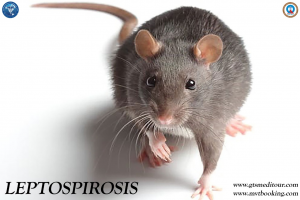DEFINITION
It is a bacterial disease that affects humans and animals.It is caused by bacteria of the genus Leptospira. In humans, it can cause a wide range of symptoms.Some infected persons, however may have no symptoms at all.
CAUSATIVE AGENT
Various members of the species L.interrogans can cause leptospirosis. L.icterohemorrhagiae cause the particularly severe type called Well’s disease.The organism can survive for weeks to months in contaminated water or soil.It enters the human body through the abraded skin mostly due to occupational exposure to rat urine contaminated soil or water
PATHOGENESIS
It causes endothelial damage to the small blood vessels,resulting in vital organ damage
CLINICAL FEATURES
The manifestations have a bi phasic pattern
- After an incubation period of 7-12 days, the first phase is septicemic phase due to leptospiremia lasting for a few days to a week.It is characterized by fever, conjunctival suffussion, severe myalgia and rashes. Lymphadenopathy and hepatosplenomegaly may be there
- The person may be relatively well for 1-3 days
- Now the immune phase starts with recurrence of fever
The immune phase may remain just as a non specific fever or progress to:
- Aseptic meningitis or
- Wells disease( jaundice, hemorrhage and renal failure). There may be hematuria, oliguria, proteinuria, casts and raised urea
COMPLICATIONS
Complications of leptospirosis include aseptic meningitis, hepatic failure, renal failure, bleeding from various sites etc
INVESTIGATIONS
- Liver enzymes are only mildly elevated as compared to viral hepatitis.
- Creatine phosphokinase is elevated to very high levels.
- Serological test by slide agglutination may be positive after the second week.False positive results are common
- Detection of specific antibody and its rise in convalescent serum is diagnostic
- Identification by dark ground illumination is plagued by frequent false positive results
- Cultures take weeks and is difficult to perform
TREATMENT
- Treatment should be started within first week itself if it is to be effective.Intravenous benzyl penicillin for 7 days is the treatment of choice
- Tetracycline for 7 days is an option for the grown up child
- Prophylaxis with weekly doxycycline may be considered if occupational exposure is likely
Prepared by:Dr Sajna Hamza A


Post a comment